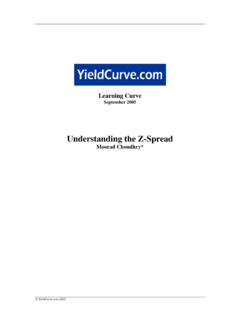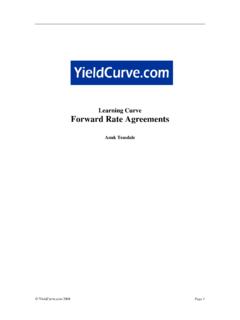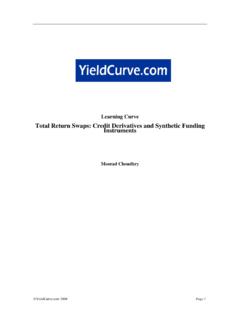Transcription of Understanding Repo Markets - YieldCurve.com
1 Understanding Repo MarketsMoorad Choudhry2(c) 2000 The Securities Institute (Services) LtdObjectives of the CoursegDefining and describing the mechanics of RepogUnderstanding market fundamentals and applying knowledge gained to daily work in the repo marketsgIntroducing trading theory and strategy3(c) 2000 The Securities Institute (Services) LtdAgendagIntroduction and market BackgroundgFinancial ArithmeticgUses and Economic FunctionsgMechanics of RepogRisks in trading RepogLegal, Accounting, Tax and CapitalgRepo nettinggOverseas and Central Bank RepogCase study -repo trades4(c) 2000 The Securities Institute (Services) LtdAgenda (cont.)gThe UK Gilt Repo MarketgTrading and Hedging StrategygElectronic Repo TradinggThe Implied Repo Rate and Basis TradinggThe Yield CurvegUsingBloombergTMScreensgIntroducti on to Equity repo5(c) 2000 The Securities Institute (Services) LtdIntroduction6(c) 2000 The Securities Institute (Services) LtdDefinition of a RepogThe term Repo is from Sale and Repurchase Agreement Repo is a money market instrument.
2 There are two usually two parties to a repo party sells bonds to the other while simultaneously agreeing to repurchase them or receive them back at a specified future dategOne party requires either the cash or the bonds and provides collateral to the other as well as compensation for the temporary use of the desired assetgAlthough legal title to the collateral is transferred, the seller/lender retains both the economic benefits and the market risk of owning themgIf cash is involved the party receiving the cash will pay interest on this cash at the agreed repo rate7(c) 2000 The Securities Institute (Services) LtdRepo Definition (cont.)gRepo is therefore a secured loangLegally : a sale and repurchase of bondsgEconomically : a secured loan of cashgThe cash investor receives the repo rategAdvantages for the cash investor.
3 --secured investment--repo rate competitive with bank deposits--diversification away from bank risk8(c) 2000 The Securities Institute (Services) LtdMarket Background9(c) 2000 The Securities Institute (Services) LtdMoney market InstrumentsgMoney market instruments have a maturity of less than one yeargSecurities quoted on a yield basisMoney market DepositsCertificates of Deposit(Repo)gSecurities quoted on a discount basisTreasury BillsBills of exchangeBankers acceptancesCommercial Paper10(c) 2000 The Securities Institute (Services) LtdBond market InstrumentsgBonds are debt capital market instruments with a maturity of over one yeargDefinition of a bond--plain vanilla or bullet bondgBond IssuergTerm to maturitygPrincipal and Coupon Rate--zero-coupon bonds; Floating-rate notes11(c) 2000 The Securities Institute (Services) LtdFinancial Arithmetic12(c) 2000 The Securities Institute (Services) LtdDiscounting and Present ValuegThe principles of compound interest are used to show that 1 today is not the same as 1 in the futuregThe effect of a (real) rate of interestgGiven a rate of 10%, we would select 1 today or in one yeargThe further into the future, the greater the compensation requirement for interest foregone because of the effect of compoundinggIn compounding we seek to find a future value given a present value13(c) 2000 The Securities Institute (Services) LtdCompounding, Discounting and Present Value (cont.)
4 GCompounding : a future value FV (given a gpresent value, a time period nand interest rate)gFV = Present Value (1+ Rate of Interest)ngTo analyse the potential economic benefit of future cash flows whose nominal value is known we employ the principle of discounting, the converse of compoundinggDiscounting : value of sum receivable at a future date today (present value PV)PV = Future Value / (1+ Rate of Interest)n14(c) 2000 The Securities Institute (Services) LtdTime value of money (cont.)gSo, present value analysis is a means by which future values can be converted into comparable present day terms using the discounting principlegA future sum to be received which includes compound interest can be expressed in relative terms to 1 todaygThe actual calculations to obtain the discount factors are rendered unnecessary by the discount function table15(c) 2000 The Securities Institute (Services) LtdFair pricing of bonds Vanilla Bond.
5 Pays fixed interest (coupon) annually or semi-annually , with return of principal at maturity Fair price of such a bond given by the discounted present value of the total cash flow stream, using market -determined discount rate (for this type of bond) The bond price / yield formula given here relates to annual coupon bond with complete years to maturity, an even number of coupon payment dates, no accrued interest16(c) 2000 The Securities Institute (Services) LtdPrice Equation()()()()()()()PCrCrCrCrMrCrMrTTT ttTT=+++++++++=+++ = of bondC=couponM=redemption payment (par)T=number ofyears to maturityr=required rate of reeturnon bond 17(c) 2000 The Securities Institute (Services) LtdPrice / yield formula(semi-annual coupons)Cr)Mr)ttTT=++( 1+= /2(1 1212122 PEstimate yield from two trial values for r , then solve using formula for linear interpolationAssumes coupons are re-invested at the required rate r18(c) 2000 The Securities Institute (Services) LtdBond Yield Yield to maturity (YTM) is the most frequently used measure of return from holding a bond, and is given by r in the previous slide s equation.
6 YTM is equivalent to the internal rate of return on the bond, the rate that equates the value of the discounted cash flows on the bond to its current price. Solution cannot be found analytically so needs to be done through numerical iteration. The price/yield formula assumes re-investment of coupons at the same yield level through life of the (c) 2000 The Securities Institute (Services) LtdYield Curve Accessing capital marketsThe pricing of debt instruments revolves around the yield curve, or term structure of interest rates, describes relationship between yield and maturity on stock differing onlyin term to maturity Types of Yield CurveRedemption yield curve; Coupon yield curve; Par yield curve; Spot (or Zero-coupon) yield curve; Forward yield curve Shape of the Yield CurveExpectations of market participants of future course of interestrates; Liquidity preference theory.
7 Segmentation theory20(c) 2000 The Securities Institute (Services) LtdPrice / Yield Relationship As the price of a bond is the sum of its discounted cash flows, a rise in rates results in a fall in price, and vice-versa Price equation shows the relationship between bond price and interest rate. Sensitivity of the bond to changes in interest rate is measured by Durationand Modified Duration. Duration is the weighted average maturity of a bond using its discounted cash flows as (c) 2000 The Securities Institute (Services) LtdHow Interest Rate Movements Affect Bond Prices At issue, a bond s coupon reflects current interest rates The coupon is fixed for the life of the bond and cannot be changed even as interest rates change It is therefore the price of the bond that changes to reflect varying market interest rates A rise in interest rates causes the bond s price to fall A fall in interest rates causes the bond s price to rise22(c) 2000 The Securities Institute (Services) LtdPrice / Yield relationship profile23(c) 2000 The Securities Institute (Services)
8 LtdAccrued Interest Virtually all bond issuers pay coupon interest once or twice a year An investor selling a bond between two coupon payments will receive from the purchaser the interest that has accrued since the last payment To the bond s clean market price is added the accrued interest, resulting in the dirty price which reflects the actual cash proceeds of the sale. The dirty price is the bond market (c) 2000 The Securities Institute (Services) LtdAccrual ConventionsC = coupon or stated rate:act/365accrued =C * days/365act/360:accrued =C * days/360act/act:accrued =C * days/actual no. of days in period30/360:accrued = C * 360 days /360(assumes each month has 30 days)25(c) 2000 The Securities Institute (Services) LtdWhat Determines Longer Term Interest Rates?gInterest rate is the cost of borrowing moneygMany rates, depending on class of borrower and termgThree key factorsCredit riskLiquidity riskMarket risk26(c) 2000 The Securities Institute (Services) LtdFunctions and Uses of Repo27(c) 2000 The Securities Institute (Services) LtdClassic RepoFirst LegBank ABank Bsells 100 worth of stockpays 100 cash for stockSecond legBank ABank Bpays 100 cash plus interestsells 100 worth of stock28(c) 2000 The Securities Institute (Services)
9 LtdClassic Repo ExamplegOn 6 September 1999 Bank A agrees to sell 1m nominal of a UK gilt, the 8% Treasury 2000, which is trading at a dirty price of value date is 7 September, term 30 days, matures 7 October and agreed repo rate is first leg of the trade Bank A passes over the stock and receives 7 October Bank B returns the gilt and Bank A pays over the original monies plus repo interest of (c) 2000 The Securities Institute (Services) LtdClassic Repo ExampleFirst LegBank ABank Bsells 1m nominal UKT 8% 2000pays legBank ABank Breturns plus interestreturns 1m nominal UKT 8% 200030(c) 2000 The Securities Institute (Services) LtdClassic Repo (cont.)gIn a classic repo the sale and repurchase prices are the same, although settlement values will differ because of addition of repo interest on terminationgA sale and repurchase is a repo , whereas a purchase and sell back is a reverse repo.
10 Of course the counterparty is either one or the other, opposite to your position!gIf a coupon is paid during the term of the repo it will be handed over to the classic repo is subject to a legal contract signed in advance by both parties31(c) 2000 The Securities Institute (Services) LtdThe Sell / Buy BackgA sell / buy back is a spot sale and forward repurchase of bonds transacted simultaneously. The repo rate is not explicit but is implied in the forward the end clean price in the trade is different to the start clean price. This simply reflects repo interest and has nothing to do with the actual market price at the payments during the term of the trade are paid to the buyer, and may be passed over at the time or handed over to the seller through incorporation into the forward price (in which case a payment is not received immediately).









